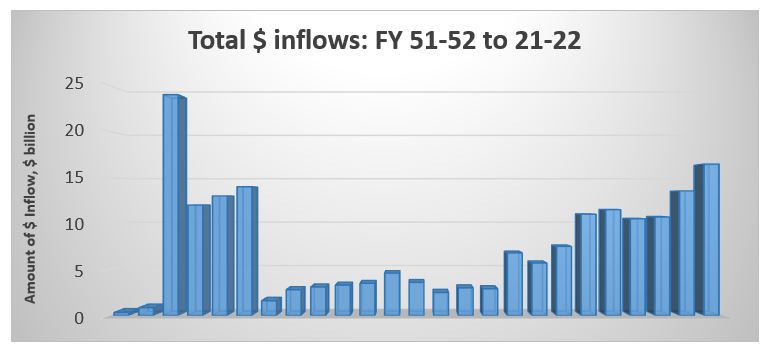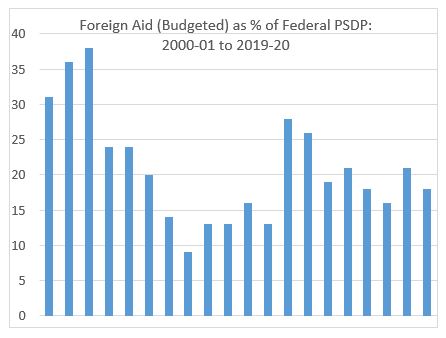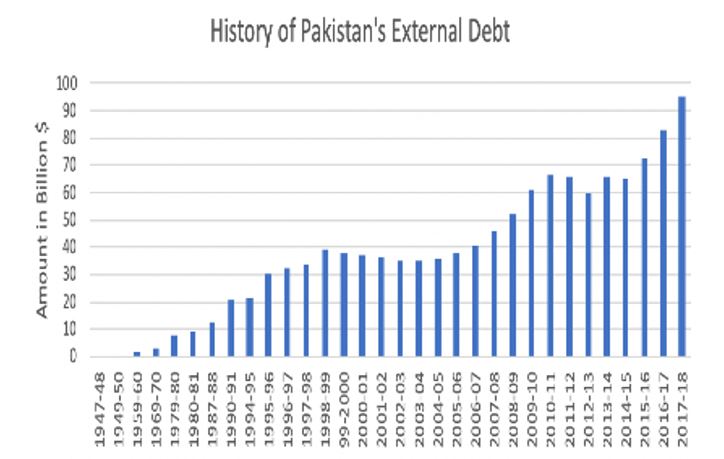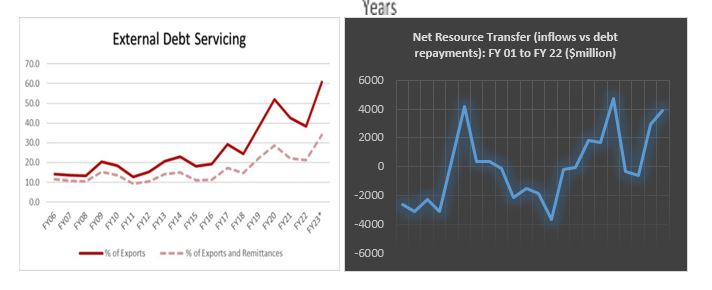So Much Aid, So Little Development!
So Much Aid, So Little Development![1]
The story of Pakistan’s economy and its management cannot be complete without bringing in the foreign aid aspect since we have been addicted to it since the very start. What started as a necessity given the adverse socio-economic conditions that necessitated external assistance later developed into an unhealthy habit of receiving regular doses of external capital, even when they were not required[2]. All in all, Pakistan has received USD 203 billion in external finance so far in its history (by two major categories, i.e. loans and grants)[3]. This is depicted in the graph below[4]–

Some other statistics of interest are as follows. Over the previous decade, on average, there are 1,268 donor funded projects operational across Pakistan. There is hardly any detailed information about any of them, especially the signed agreements/contracts. Of all the debt taken over the course of its history, Pakistan has repaid back approximately USD 135 billion in interest and principal charges[5]. Bifurcated by loans and grants, approximately 78 percent of all assistance is in the form of credit. There is little or no information about the domestic and foreign organisations executing the projects and other related details (consultancy and administrative charges, etc.).
But aside from mere numbers, there are underlying trends and some hitherto lesser-discussed (or deliberately concealed?) facts that need to ring alarm bells in policymaking circles. We first start with the fact that the majority of projects currently being implemented in Pakistan, especially in the public sector, are rarely analysed for effectiveness. This, in turn, creates confusion as to the purpose and effectiveness of foreign aid in Pakistan. As it turns out, there are good criterion for judging the effectiveness of foreign aid, which came about after extensive debate in western capitals upon this issue, specifically in the post-WWII period[6]. In summary, effective aid:
- Involves a transfer of resources that does not create future liabilities, especially long-term ones
- Is not source-tied to the creditor country, especially projects and services
- Leads to development in a manner that is sustainable and self-sustaining over the long-run
- Raises marginal savings rate in nations receiving aid, in turn leading to higher capital formation
- Facilitates the formation of additional capital in a manner that is complemented by a development program that helps enlarge the economy-wide capacity to absorb additional capital productively
- Triggers sustainable economic growth via additional capital formation
The detailed discussion of all these criterion, in the context of economic outcomes in Pakistan, is beyond the scope of this piece. However, available evidence clearly points to the fact that hardly any of these criterion have been met. In fact, as argued in the following lines, foreign aid is becoming a monetary as well as non-monetary burden upon Pakistan!

The first point relates to the ‘dependency syndrome’. An excellent reflection of this dependency comes in the form of the foreign aid component in our premier development program, the PDSP. As the accompanying graph shows, it constitutes a huge proportion of our federal development financing. This clearly violates a few of the above mentioned criterion, specifically additional capital formation and increased savings rate that should have decreased (or eliminated altogether) with the need for foreign financing for development. This also leads to increasing our future liabilities, demonstrated by a recent PIDE publication on PSDP, which informs us that not even half of foreign commitments tend to materialise, leading to delays and ‘throw-forward’ costs that now stand at Rs. 8 trillion, a huge future liability[7].
A related concern is the waste, corruption and rent-seeking that pursuit of foreign aid puts into motion. The method and negotiations of foreign debt remain obscure, with high ranking officials exclusively getting to negotiate and realise returns in the form of foreign tours, sizeable project allowances and working in major donor institutions while in-service (deputation) or immediately post-retirement, despite having no prescribed qualification. It’s a classic reflection of the ‘you scratch my back; I scratch yours’ principle.
Additionally, this needlessly increases Pakistan’s liabilities! A good reflection of this comes in the form of ‘commitment charges’ that Pakistan has to pay on loans for which there is little to no need for and the capacity to spend[8].


We now consider three important graphs shown above. In aggregate, the first two graphs (external debt and external debt servicing) again brings forth the point that despite substantial aid inflows, capital accumulation and savings have remained low, forcing us to contract even more external debt – thus increasing our present and future liabilities in the form of total external debt and substantial payments on external debt servicing.
The third graph is even more damning as it shows that in the 21st century, there has been a ‘Net Resource Transfer’ (inflows – outflows) of an estimated USD 50 billion from Pakistan to external creditors, a situation that is both unsustainable and a reflection of Pakistan racking up additional liabilities, as well as violating the criterion of resource transfer from developed to developing countries.
And last, but not the least, development indicators of Pakistan have barely budged despite substantial aid inflows. The best reflection of this is Pakistan’s Human Development Indicators (HDI) over time. As the table below clearly reflects, the indicators have barely improved.
| Table. Pakistan’s Disaggregated Human Development Indicator (HDI) | |||||
| Region | 2000 | 2005 | 2010 | 2015 | 2019 |
| Total | 0.448 | 0.486 | 0.513 | 0.536 | 0.558 |
| AJK | 0.532 | 0.583 | 0.606 | 0.606 | 0.612 |
| Baluchistan | 0.424 | 0.459 | 0.454 | 0.455 | 0.475 |
| FATA | 0.416 | 0.449 | 0.464 | 0.46 | 0.465 |
| Gilgit-Baltistan | 0.469 | 0.505 | 0.522 | 0.553 | 0.592 |
| Islamabad (ICT) | 0.568 | 0.619 | 0.682 | 0.69 | 0.677 |
| Khyber Pakhtunkhwa | 0.437 | 0.472 | 0.503 | 0.516 | 0.527 |
| Punjab | 0.433 | 0.469 | 0.51 | 0.542 | 0.564 |
| Sindh | 0.433 | 0.472 | 0.505 | 0.522 | 0.532 |
In summary, there’s so much aid, but little in terms of true development. All this calls for a serious introspection of foreign aid policies in Pakistan.
The author is a Research Fellow at the Pakistan Institute of Development Economics (PIDE), Islamabad.
[1] The title is borrowed from Dr. Samia Altaf who published her book on Social Action Program (SAP) with the same title. The data used in this article is based on authors’ calculation based on various sources (Govt. of Pakistan, OECD, etc.), used in upcoming PIDE report on foreign aid
[2] The list of such loans is countless. FBRs recent ‘capacity building’ loan from the World Bank, amounting to $400 million, is an example. The WB also loaned the same amount a decade earlier under the same title, with little positive occurring in terms of final outcome.
[3] This does not include external loans raised through debt instruments like Euro Bonds, which constitute a small part of the whole
[4] Note that $203 billion amount includes FY22-23 inflows (not in graph). Also, higher bars in earlier years depict bunched years (5 year inflows, for e.g) rather than single years
[5] Estimates based on Finance Division Economic Surveys and SBP data
[6] See, specifically ‘Objectives of the United States economic assistance programmes’, (1957), MIT. This report was used in conjunction with research by Walt Rostow and Mark Millikan (‘The Millikan-Rostow Proposals’), published as ‘A proposal: Key to an effective Foreign Policy’ (1957). Also see Bhagwati and Eackus (1970) for an extensive discussion of views on foreign aid
[7] ‘Reforming the Public Sector Development Program’ (2023), PIDE
[8] For example, in 2017-18, out of the $2.9 billion loaned to Pakistan’s power sector by Asian Development Bank (ADB), only $400 mil had been utilized! On the unutilized ADB loans, Pakistan paid a commitment charge of $7-8 million





